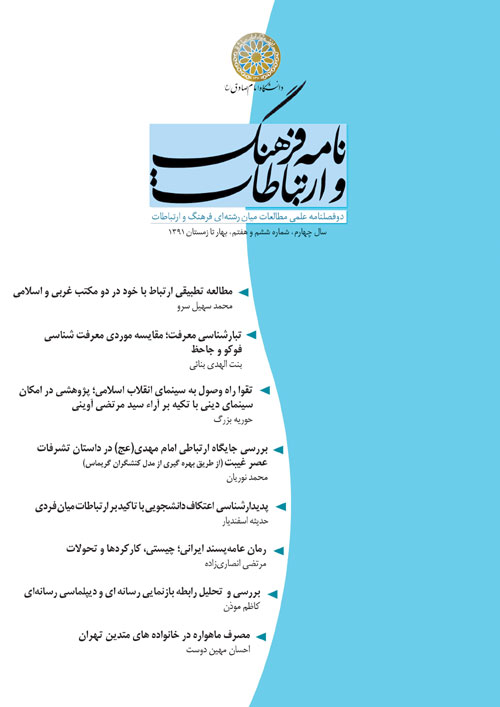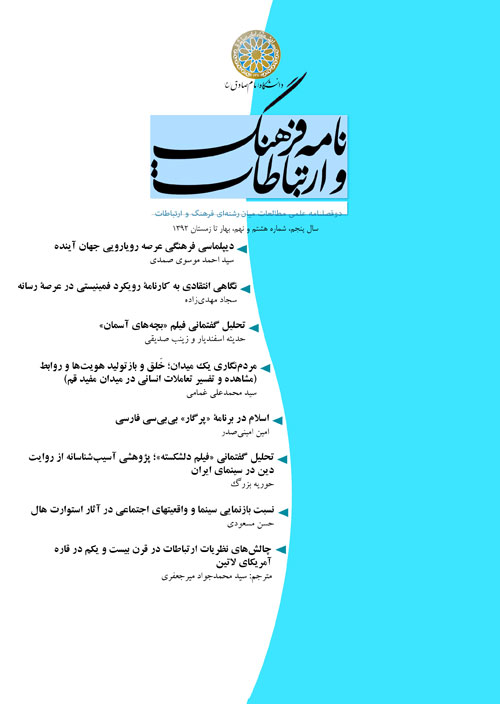فهرست مطالب

نشریه مطالعات میان رشته ای فرهنگ و ارتباطات
پیاپی 6-7 (بهار و زمستان1391)
- بهای روی جلد: 40,000ريال
- تاریخ انتشار: 1394/02/26
- تعداد عناوین: 8
-
Page 9This article intends to examine two different approaches to selfcommunication which has important effect on understanding other types of communication. To this end, it tries to make a survey of western scholar's views about it. It then reviews Islamic narratives and the holy Quran in search of their treatment of the subject. It seems that their dissimilar definition of the self, i.e. the western insistence on the social effect and the Islamic focus on varieties of the self and relating with each of them constitute the differentiation between the two trends. Obviously, despite the theoretical character of this discussion, the results obtained depict similarities and differences between the two trends around subjects like the essence, kinds and levels of the self and the knowhow of communicating with it, and lead to a development of our understanding and application of this kind of communication and its extension to other communication levels.Keywords: communication, self, communication, self
-
Page 33Comparing scholar's views especially in humanities is a common beneficial act the interruption of which can stop the development of knowledge. Though detecting similarities among scholars who come from distant ages and places seem striking, recognition of the reason behind the similarities is also necessary. As an example we can refer to Foucault and Jahiz who come from different ideological and historical background, but they share some affinities in thought. The aim of this study is in fact seeking those circumstances which led to the rise of scholars like Jahiz, a situation that can produce similar trends of thought in other thinkers elsewhere. To do this, the historical circumstances of the above- mentioned scholars are studied genealogically after comparing their views. The result of the study shows that decentralization and cultural discrimination policies, and establishing cultural centers are those shared cultural and historical elements that provided the necessary conditions for the appearance of the two thinkers and resulted in a special form of thinking and knowledge.Keywords: genealogy, knowledge, French, Abbasi, Foucault, Jahiz
-
Page 61People's increasing interest in cinema in recent years has necessitated conveying religious messages and filling the theoretical gap in regard to religious cinema more than ever. Seyyed Morteza Avini was one of the few religious cineasts and thinkers who in the post- revolution years endeavored to take some step in this field especially through his published articles. This research has reviewed Avini's opinions about the cinema with the aim of disclosing the potentials of this special media. The emphasis is on the factor of a Muslim cineaste and his relation to this media and its audience with the help of a descriptiveanalytical method. The results show that in this kind of relationship in order to achieve the desired cinema and by considering the essential influence of related technologies we need to go deep into the problem and have a full command of the technologies. This happens only by loosening the grip of subjectivity and prioritizing the objectivity i.e. letting the artist's heart and soul act as mirrors held up to realities around. In regard to cineaste/ audience relation, the way to achieve the desired goal, in Avini's view, is to find the technique well adjusted with each message on the part of the cineaste, and tend to a gradual transformation of the predominantly distraction seekers by referring to their natural human needs.Keywords: Seyyed Morteza Avini, cinema, Muslim cineaste, audience, occupation, technique
-
Page 81The Occultation Period's stories of Imam Mahdi's meetings hold a valuable place among Shias. "Imam", as God's evidence, is considered to act as an intermediary between Him and mankind, a status that is definable at various levels. The study of Imam Mahdi's status in Meeting stories is what the researcher is investigating. To do this some communicative models which have organizational function have been utilized in order to provide a description of the stories. Besides a documentary scrutiny, we can analyze the stories from a narrative structure point of view. This research tries to borrow from narrative analysis from the standpoint of structuralism which is the same as the principal theoretical developments and a regard of Prop development process, and ultimately pursues the final model based on Grimas classification of narrative actions. This has been done determining the six fold action that underlies the analysis of each story. The overall results were analyzed on the basis of one of the communicative models, in which Imam Mahdi appeared with different roles, namely hero, assistant, sender,etc.Keywords: Imam Mahdi, narrative analysis, Grimas Actiontial model, communicative model
-
Page 111The article examines the practice of retreat by insisting on interpersonal communication. This event is usually considered to be a personal and devotional phenomenon and its social aspects seem to be neglected. The question is if it is also social and, in case the answer is positive, what could its effects be on interpersonal communication? Does this kind of communication lead to any effectiveness? To answer these, by investigating into retreat from the point of view of those who practice it, and also its latent and explicit features, we have tried to provide clear answers to the questions.Keywords: retreat, anthropology, interpersonal communication
-
Page 141Pulp fiction which deals with the mass of people’s tastes is an important subject in cultural studies. This article first discusses the features of Iranian pulp fiction. Pros and cons, functions, reasons of people’s interest, women and pulp fiction, form and content features, and difference with foreign pulp fiction, are among the investigated issues. Finally, cultural studies consideration of pulp fiction is explained. The results showed that femininity, romantic orientation, simplicity of prose, linear narrative, and happy ending have been identified as basic features of Iranian pulp fiction, and on the basis of these a final definition of Iranian pulp fiction is given.Keywords: pulp fiction, cultural studies, women
-
Page 171This article tries to determine different dimensions of media diplomacy by utilizing its peripheral concepts and then deals with its conceptual typology in an academic context. The next step is to clarify the meaning of media representation and its degree and manner of relationship with the former concept. There are two general approaches to media diplomacy: one which classifies it under general diplomacy and one which takes it as an instrument for influencing the rulers and statesmen of another country. Media diplomacy researchers hold communication as a mere unilateral process and a propagandist tool with 100% effectiveness. The relation between media diplomacy concept and media representation can be established only when media diplomacy tends to affecting people and not the officials. This is because general analyses based on media representation have a general view of the media, and their focus on production and creation of meaning is based on conceptual and discourse frameworks. In fact, from among the mentioned definitions about media diplomacy those which are similar to general diplomacy can have a larger relation with media representation. Should media diplomacy assist in analyzing the data obtained from media representation study, it must be let out of its predominant restrictive framework.Keywords: media diplomacy, media representation, general diplomacy, communication sciences
-
Page 197The article is part of a research in response to the question about Tehran's Religious familie's consumption of Satellite TV programs. Besides common questions such as "How much do people use the media?", "What do the media produce?" we can also deal with this essential question:"What do people do with the media and how do they consume it?" This research is a qualitative and descriptive one and its data are collected through in-depth interviews with 15 households. The subjects were selected by snowball sampling in Tehran. The results show that religious families use satellite TV programs in case they could have them under control and could prevent inappropriate use of it.


